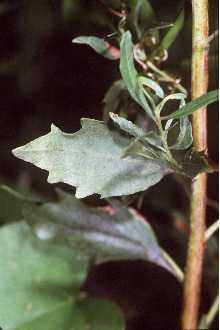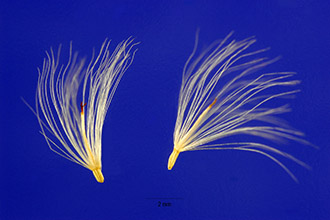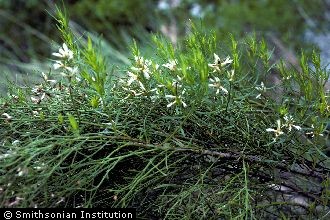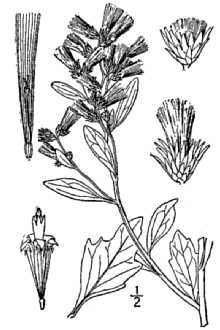Baccharis halimifolia L. var. angustior DC.
Scientific Name: Baccharis halimifolia L. var. angustior DC.

| General Information | |
|---|---|
| Usda Symbol | BAHAA |
| Group | Dicot |
| Life Cycle | Perennial |
| Growth Habits | ShrubTree, |
| Native Locations | BAHAA |
Plant Guide
Uses
The native groundsel tree is recommended as a garden shrub or hedge in Florida because of its hardiness, freedom from disease, fall flowering, and resistance to salt spray. The female plants, in particular, with their densely silver-green aspect, are beautiful when few other plants are flowering. Plants can be trained to a single trunk – tree-like and up to 10 feet tall. It is a useful shrub for reclaiming moist or wet sites, including retention areas and drainage ponds. Although it apparently has little or no value as a good food source for game animals (“wildlife”), groundsel tree provides cover and nesting habitat for various species of birds. Bees and small butterflies use the abundant nectar from the male flowers, which in turn attract songbirds to forage on the insects. © William S. Justice Botany Dept., NMNH, Smithsonian Institution @ PLANTS
Status
Please consult the PLANTS Web site and your State Department of Natural Resources for this plant’s current status, such as, state noxious status and wetland indicator values.
Description
General: Sunflower Family (Asteraceae). Deciduous shrubs 1-2(-6) m tall, sometimes single-stemmed from the base and tree-like. Leaves: deciduous, obovate to elliptic or narrowly elliptic-oblanceolate, 3-nerved, 2-6 cm long, smooth-margined or with 1 tooth or 1-3 pairs of coarse teeth on the upper margins, the surfaces slightly resinous, usually with small dots. Florets closely clustered in heads surrounded by involucral bracts, the heads borne in tight aggregations; heads of two sexes, each produced on a separate plant (the species dioecious) –– the staminate heads (pollen-producing, with sterile ovaries) with only tubular, 5-lobed corollas; the pistillate heads (with fertile ovaries) with only thread-like corollas. Fruits (“cypselae” or achenes) are 1-seeded, nearly cylindric, 1.3-1.8 mm long, topped by a ring of numerous, slender, flexible, silvery-white bristles (the “pappus”), which elongates at achene maturity to 10-12 mm long, much longer than the involucre. The small fruits are shed with the pappus, a wind-catcher that enables fruit dispersal over a wide area. In a steady wind of about 17 km/hour, drift of seeds from a shrub two meters in height has been recorded up to 140 meters. The common name “silverling” alludes to the silvery aspect of pistillate plants in the fall, when the pappus of each maturing fruit elongates and protrudes from the head. Variation within the species: Plants of this species from the West Indies have been called Baccharis halimifolia var. angustior DC., but there appears to be little justification for their formal recognition. Baccharis halimifolia closely resembles the Mexican species Baccharis heterophylla Kunth. Where both occur in Veracruz, Mexico, B. halimifolia can be recognized by its habitats along the coast or coastal plain, its more gradate, blunt-tipped involucral bracts, and its longer pappus. Plants from central Nuevo León, Mexico, have narrower leaves than typical for B. halimifolia, but in most respects they are more similar to it than to B. heterophylla. Baccharis halimifolia hybridizes with B. neglecta Britt. where the two meet in east Texas. Groundsel tree is a member of the sunflower family, but the sunflower-like nature of the heads is not evident without close inspection. Baccharis halimifolia is the species upon which the concept of the genus Baccharis is based (the type species).
Distribution
For current distribution, please consult the Plant Profile page for this species on the PLANTS Web site, Use soil moisture sensors to measure the soil moisture of Baccharis halimifolia L. var. angustior DC.., Groundsel tree occurs in all states bordering the Atlantic Ocean and Gulf of Mexico, plus the Caribbean and into northeastern Mexico as far south as Veracruz and San Luis Potosí,
Establishment
Adaptation: Groundsel tree grows on beaches, marshes and hammocks near the shore, and various more inland sites, including ditches, old fields, and roadsides. Flowering in the United States occurs mainly in August-December. General: Plants of groundsel tree as young as 3 years may produce viable seed. Because it is dioecious, male and female plants are necessary for seed production. There is no dormancy requirement for germination. Other reasons for its colonizing success are prolific seed production and high seed germination percentage, long-range seed dispersal, shade tolerant seed production, wide adaptability to soil nutrients and salinity, survival in extreme wet soil conditions, and ability to resprout after fire. Groundsel tree can be cultivated in a sunny location. It does not tolerate heavy clay soils but can be successfully grown in nutrient-poor soil. Most native coastal plain habitats are sandy. In its resistance to salt spray, it is useful in coastal situations. It is a fast-growing plant and will quickly regrow, even if cut back to the base.
Management
Probably from initial introductions of groundsel tree as an ornamental into western Europe (France, Spain, and Italy) and Queensland, Australia, it has become an invasive weed, rapidly occupying open sites and encroaching into grassland and parkland. Because animals apparently find it unpalatable (the leaves and flowers contain a cardioactive glycoside), it is common to see the species growing in abundance in pastureland. Groundsel tree is toxic to livestock, causing staggering, trembling, convulsions, diarrhea, and other gastrointestinal symptoms, but this feature is less significant than the displacement of other vegetation through its rapid colonization. This native species has been regarded as an “infestation” on overgrazed rangeland in the southern United States. Various native species of beetles and moths are known to feed on leaves and buds of Baccharis. Larvae and adults of several of these are capable of defoliating plants of groundsel tree. North American gall-forming midges, seed-feeding bugs, and stem borers also cause damage and some have been introduced into Australia as agents of biological control for Baccharis halimifolia. Cultivars, Improved and Selected Materials (and area of origin) These plant materials are somewhat available from commercial sources. Contact your local Natural Resources Conservation Service (formerly Soil Conservation Service) office for more information. Look in the phone book under ”United States Government”. The Natural Resources
Conservation
Service will be listed under the subheading “Department of Agriculture.”
References
Boldt, P.E. 1989. Baccharis, (Asteraceae), a review of its taxonomy, phytochemistry, ecology, economic status, natural enemies and the potential for its biological control in the United States. MP 1674, Texas Agric. Expt. Station, Texas A&M Univ., College Station, Texas. Cronquist, A. 1980. Vascular Flora of the Southeastern United States. Vol. 1. Asteraceae. Univ. of North Carolina Press, Chapel Hill, North Carolina. Nesom, G.L. 1990. Infrageneric taxonomy of North and Central American Baccharis (Asteraceae: Astereae). Phytologia 69:40–46. Zanowiak, D.J. 1991. An analysis of systematic and phyletic relationships within the Baccharidinae (Asteraceae: Astereae). Ph.D. Dissertation, Texas A&M University, College Station, Texas.
Fact Sheet
Alternate Names
groundsel tree, saltmyrtle, seamyrtle, silverling Warning: The leaves of this plant are poisonous to livestock.
Uses
Eastern baccharis plants are dioecious, meaning there are separate male and female plants. The female plants are particularly attractive in flower and make a good landscape plant in exposed coastal conditions. This plant is highly resistant to salt spray and flooding. Habitat: Marsh wrens and other small birds frequently nest in the openly branched, brittle stems. Erosion control: This plant is currently being investigated for application in soil bioengineering systems to stabilize tidal shorelines because of its ability to root from a dormant, unrooted cutting.
Status
Please consult the PLANTS Web site and your State Department of Natural Resources for this plant’s current status (e.g. threatened or endangered species, state noxious status, and wetland indicator values).
Description
©William S. Justice Smithsonian Institution @ USDA NRCS PLANTS Eastern baccharis is a deciduous shrub, up to 10 feet tall; with simple, thick egg-shaped leaves (up to 2.5” long). It is a U.S. native. Leaves are mostly coarsely toothed above the middle of the leaf, and the uppermost leaves have smooth margins; they are alternately arranged. Baccharis has small heads of white flowers in stalked clusters that form terminal leafy infloresences. The fertile heads are very showy and cottonlike. Although deciduous, the naked stems remain slightly green throughout the winter. Baccharis is often confused with high-tide bush (Iva frutescens) which has opposite, regularly toothed leaves and bare, gray stems in the winter.
Adaptation and Distribution
Distribution
Distribution
Eastern baccharis grows naturally in the upper fringes of irregularly flooded tidal fresh and brackish marshes, back dunes and inland open woods, vacant fields, and desert habitats from Massachusetts to Florida, Arkansas, and Texas. For a current distribution map, please consult the Plant Profile page for this species on the PLANTS Website.
Establishment
These plants are most commonly installed as 1 to 2 year old containerized material, Investigations are underway to determine the rooting ability in the field from a dormant unrooted cutting, If rooting success is high, the potential exists for incorporating baccharis into soil bioengineering systems for tidal shoreline stabilization, Use soil moisture sensors to measure the soil moisture of Baccharis halimifolia L. var. angustior DC..,
Management
The facultative light requirement of baccharis seeds may provide one opportunity for effective management to control the species as a weed. The maintenance of a dense stand of pasture, plantation or native cover may effectively shade the ground surface, discouraging seed germination. The loss of viability of seed after 14 months or less implies that local eradication of a population at a single point in time could rapidly curb regeneration. On the other hand, prolific seed production from a single plant will avoid eradication.
Pests and Potential Problems
A beetle, Trirhabda baccharidis, may assist in reducing seed viability and potential rate of spread in semi-tidal areas, but it is not anticipated that it will effect any significant reduction in the groundsel bush infestation outside such areas.
Plant Traits
Growth Requirements
| Temperature, Minimum (°F) | -3 |
|---|---|
| Adapted to Coarse Textured Soils | Yes |
| Adapted to Fine Textured Soils | Yes |
| Adapted to Medium Textured Soils | Yes |
| Anaerobic Tolerance | High |
| CaCO3 Tolerance | Low |
| Cold Stratification Required | No |
| Drought Tolerance | Low |
| Fertility Requirement | Low |
| Fire Tolerance | Medium |
| Frost Free Days, Minimum | 180 |
| Hedge Tolerance | Low |
| Moisture Use | High |
| pH, Maximum | 7.8 |
| pH, Minimum | 5.5 |
| Planting Density per Acre, Maxim | 2700 |
| Planting Density per Acre, Minim | 700 |
| Precipitation, Maximum | 60 |
| Precipitation, Minimum | 36 |
| Root Depth, Minimum (inches) | 20 |
| Salinity Tolerance | High |
| Shade Tolerance | Intermediate |
Morphology/Physiology
| Bloat | None |
|---|---|
| Toxicity | None |
| Resprout Ability | Yes |
| Shape and Orientation | Erect |
| Active Growth Period | Spring, Summer, Fall |
| C:N Ratio | High |
| Coppice Potential | No |
| Fall Conspicuous | Yes |
| Fire Resistant | No |
| Flower Color | White |
| Flower Conspicuous | Yes |
| Foliage Color | Dark Green |
| Foliage Porosity Summer | Dense |
| Foliage Porosity Winter | Moderate |
| Foliage Texture | Coarse |
| Fruit/Seed Conspicuous | No |
| Nitrogen Fixation | None |
| Low Growing Grass | No |
| Lifespan | Moderate |
| Leaf Retention | No |
| Known Allelopath | No |
| Height, Mature (feet) | 10.0 |
| Height at 20 Years, Maximum (fee | 10 |
| Growth Rate | Moderate |
| Growth Form | Multiple Stem |
| Fruit/Seed Color | White |
Reproduction
| Vegetative Spread Rate | None |
|---|---|
| Small Grain | No |
| Seedling Vigor | Low |
| Fruit/Seed Period Begin | Fall |
| Seed Spread Rate | Slow |
| Seed per Pound | 85000 |
| Propagated by Tubers | No |
| Propagated by Sprigs | No |
| Propagated by Sod | No |
| Propagated by Seed | Yes |
| Propagated by Corm | No |
| Propagated by Container | Yes |
| Propagated by Bulb | No |
| Propagated by Bare Root | Yes |
| Fruit/Seed Persistence | Yes |
| Fruit/Seed Period End | Fall |
| Fruit/Seed Abundance | High |
| Commercial Availability | Routinely Available |
| Bloom Period | Late Summer |
| Propagated by Cuttings | No |
Suitability/Use
| Veneer Product | No |
|---|---|
| Pulpwood Product | No |
| Post Product | No |
| Palatable Human | No |
| Nursery Stock Product | No |
| Naval Store Product | No |
| Lumber Product | No |
| Fodder Product | No |
| Christmas Tree Product | No |
| Berry/Nut/Seed Product | No |



